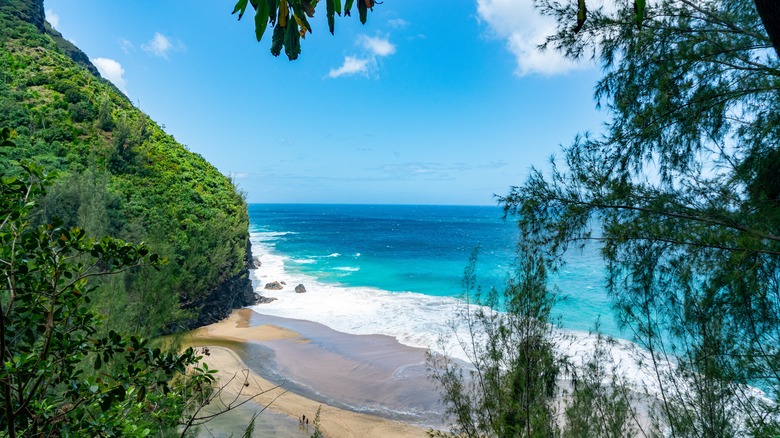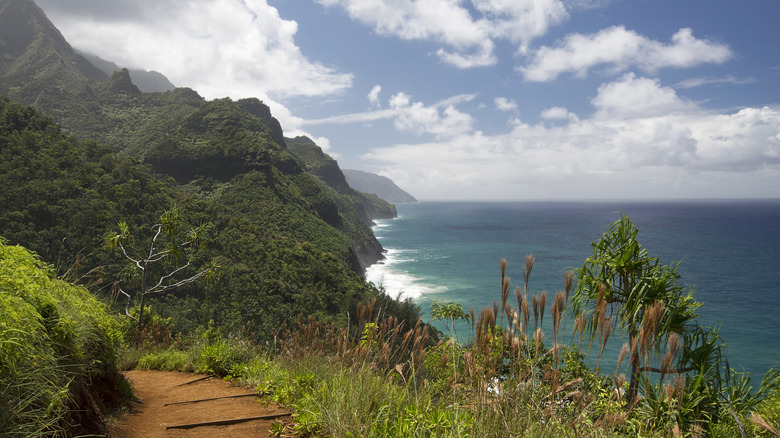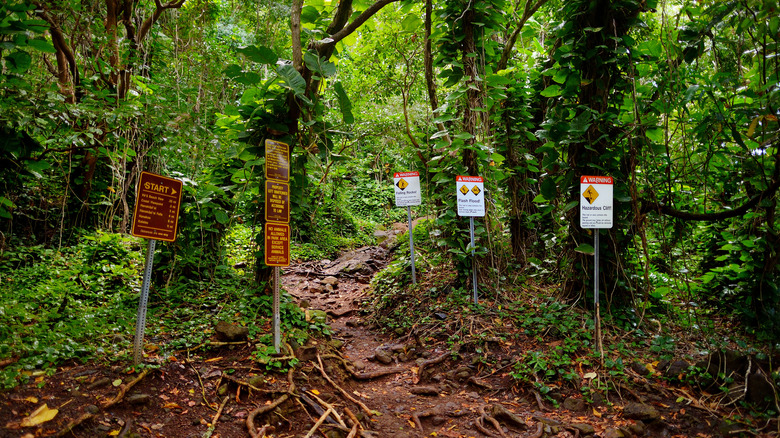Why Hawaii's Most Beautiful Hiking Trail Is Also Considered Its Most Dangerous
Nestled along the Nāpali Coast on the island of Kauai in Hawaii, the Kalalau Trail covers 11 miles of exquisite terrain. The trail begins at Ke'e Beach at Haena State Park and ends at Kalalau Beach, where travelers reach a waterfall called Hanakapi'ai Falls. It's epic stuff. The trail spans cliff sides and valleys, and takes travelers over streams and down lush forests, with a view of the Pacific Ocean as its momentous backdrop.
The rugged Nāpali Coast, with its steep cliffs, is a tough place to access, though. There's the option of helicopter rides, and visitors and locals can boat along the waterline, but the Kalalau Trail offers the only land-based route to this part of Kauai. The terrain is simply too inaccessible to get there any other way on foot. The spectacular natural setting makes it a compelling trip for hikers, but because of the treacherous terrain, the Kalalau Trail is also the most dangerous one in Hawaii, making it a solid contender for a spot on the most dangerous hiking trails in the world. Many hikers have died and countless others have been seriously injured. People fall from the sheer cliffs while others drown trying to cross the streams that get hit by flash floods; still others have drowned while swimming in the adjacent ocean, which is notoriously rough and unpredictable. In 2014, over 120 hikers had to be saved by helicopters after flooded streams made the trail impossible to cross. It's no small thing to hike the Kalalau Trail.
What makes the Kalalau Trail so dangerous
There are several factors that make the Kalalau Trail so treacherous for hikers. Since the trail hugs the coastline of Nāpali, many sections of the hike are steep and rocky, with sheer drops to the ocean. The trail passes through several creeks and streams, making the area slippery and wet. Travelers have to make their way through mud, or carefully climb the wet rock that makes up other parts of the trail. Flash flooding can glut the streams, obstructing the walking path ahead.
What makes the trail even more difficult is that hikers must climb steep areas, then navigate descents into valleys, all while dealing with extreme heat and humidity. Even advanced hikers can get exhausted, making it that much harder to navigate the more precarious portions of the trail. Swimming while walking the Kalalau Trail is also dangerous. Hikers can meander off the main path in areas to reach the ocean, but the currents along the Nāpali coast are unpredictably powerful and many have drowned in the area.
In 2018, 27 hikers got trapped on the Kalalau Trail after an epic storm broke out. The hikers were stranded on the trail and as smaller groups began attempting to get back, they got lost continuously, since the rain had washed away any identifiable markings on the trail. Some had to be evacuated by helicopter. So this trail is not an easy thing.
How to hike the Kalalau Trail safely
While the Kalalau Trail is notoriously dangerous, there are certain steps to take to make it as safe as possible, though there's no guarantee that the trip will be easy. If you want to camp, you need to get a permit ahead of time from the State of Hawaii,so plan accordingly. Since heavy rains make the trail slippery and bring on flash floods, it's best to hike during the summer months, from mid-May to early October to mitigate chances of encountering heavy rains. December to February is the rainiest and therefore most dangerous time to hike the trail. Check the weather before your hike, and do not cross any streams that go above your knees. Do not swim in the ocean in this area. Be mindful of the terrain above you, as falling rocks also pose a risk to hikers.
When you go hiking, you need to wear durable hiking shoes and bring water. The streams along the way are not potable. Sunscreen and sun protection is also non-negotiable. It's extremely wise to hike the trail with at least one other person, as solo hikes on the Kalalau Trail makes things even more risky. Should anything happen, other members of the group can hopefully get assistance. Cell phone service is spotty at best, and nonexistent on most parts of the trail, so the only way to get help is to search it out on foot.


